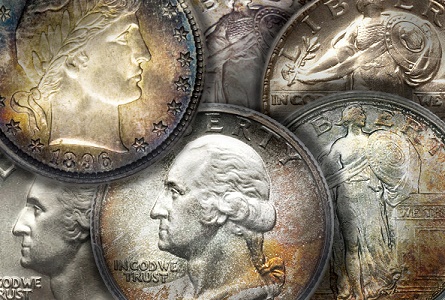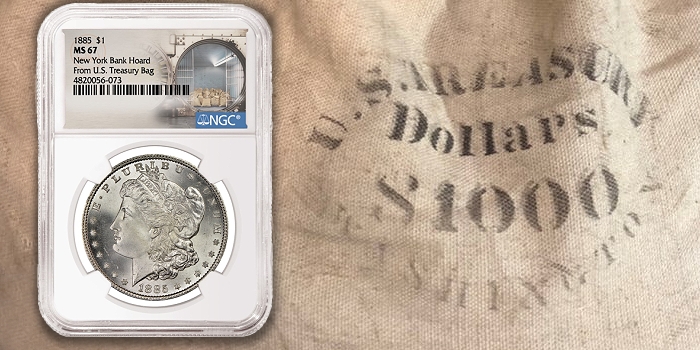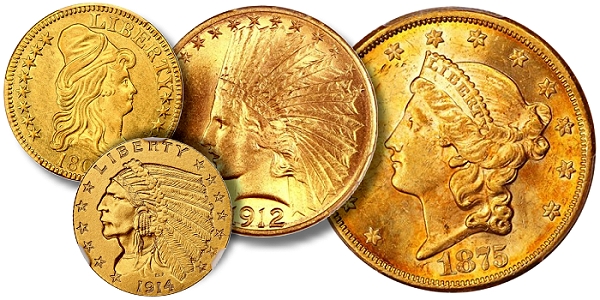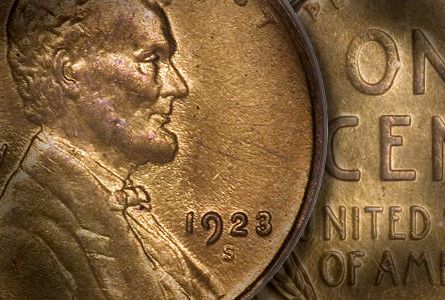Ten answers to the question: What coins should I pursue in U.S. Coin Collecting ?
By Jeff Garrett for Numismatic Guaranty Corporation (NGC) ……
I often have conversations with others about the growth of numismatics. Most, if not all, agree on the importance of attracting young people to the hobby.
Not long ago, I spoke with a marketing director for the Royal Canadian Mint. Their research shows that it is very important to target people ages 6-12, with the knowledge that they will most likely leave the hobby temporarily. The hope is that they will return to the hobby after they have established careers. The mint’s idea, in essence, is to plant numismatic seeds.
The new director of the United States Mint, David Ryder, reportedly also has been looking into how to attract young people to U.S. Coin Collecting. The recent issue of “W” quarters (with a West Point mintmark) into circulation was a great idea, one that I know for a fact got many young people and adults looking at their change for the first time in years.
The U.S. Mint is reported to be considering minting its first colorized coin in the near future.
This approach is different from decades ago when people started as kids in U.S. Coin Collecting and continued through adulthood. Beginning collectors would buy a coin album and attempt to find the coins in their change. Like millions of others, this is how I started collecting. Today, when young or middle-aged people re‐discover the hobby, they will most likely start collecting vintage coins.
I am often asked by people in this stage of the hobby to advise them about what to collect. They have an interest in numismatics but are confused about where to start.
Picking coins from circulation is not an option for these folks and usually, they’re trying to find an interesting series to focus on. Their nearly endless U.S. Coin Collecting choices are limited only by their budget, and they typically try to find a series that they can afford.
U.S. Coin Collecting offers many opportunities and, with patience, you will probably find a series or issue that will be exciting and profitable to collect.
The following are just a few of the possible ways to start your coin collection.

Silver Eagles: 1986 to Date, MS and PF 69
Many individuals discover numismatics after purchasing silver bullion or an American Silver Eagle. The recent rise in bullion prices will bring a lot of new rare coin buyers into the market. Assembling a complete collection of these in NGC MS 69 is a relatively easy project and can be accomplished for less than $1,500 USD.
A complete set with all MS and PF coins would cost around $12,500.
The complete set looks quite impressive and there is a rather strong bullion play. The only downside is that some of the issues are quite common and for you to make money, silver would need to rise substantially.

20th-Century Type Set: MS 63 or Better
This set would include every coin made in the 20th century and is quite easy to assemble. The most difficult to find are the Barber coins: the dime, the quarter, and the half dollar designed by United States Bureau of the Mint Chief Engraver Charles E. Barber and minted between 1892 and 1916.
The set offers an interesting window into this era’s history of the United States and includes some of the most beautiful and popular coins ever stuck, such as the Standing Liberty quarter and Walking Liberty half dollar. The set can be completed for less than $2,000.

Morgan Silver Dollars
No list of possible ways to start U.S. Coin Collecting would be complete without mentioning Morgan silver dollars, which probably are the most popular United States coin.
Assembling a complete set in Mint State is beyond the means of most collectors. Many try to purchase as many different dates as possible in the highest grade they can afford. There are dozens of issues that can be purchased for less than $100 in Mint State.
There is an amazing amount of literature about the series, and as usual, I recommend that you do your homework before taking on the task.
Assembling a set of Morgan dollars can be a lifetime pursuit for a serious numismatist.

United States Gold Type Set
United States gold coins are an incredible value in relation to gold bullion prices. The premium over the bullion price is the lowest in my 40-year career. You should consider assembling a basic eight- or 12-piece type set. The set is quite attractive and should be purchased in the highest grades you can afford. Most U.S. Coin Collecting choose coins graded NGC MS 63 or better.
The eight-piece set consists of the following:
- Liberty Quarter Eagle, 1840‐1907
- Liberty Half Eagle, 1866‐1907
- Liberty $10, 1866‐1907
- Liberty Double Eagle, 1877‐1907
- Indian Quarter Eagle, 1908‐1929
- Indian Half Eagle, 1908‐1929
- Indian $10, 1907‐1933
- Saint-Gaudens Double Eagle, 1907‐1933
The 12-piece type set includes the above plus the following:
- Liberty Gold $1, Type One, 1849‐1854
- Liberty Gold $1, Type Two, 1854‐1856
- Liberty Gold $1, Type Three, 1856‐1889
- Gold $3, 1854‐1889
Walking Liberty Half Dollar Short Set: 1941‐47
The Walking Liberty series started in 1916 and runs through 1947. The early dates of the series, 1916‐1940, are full of very expensive and elusive rarities, especially in Mint condition. Many collectors choose to assemble a complete set from 1941 to 1947, commonly referred to as a “Short Set”.
An NGC MS 65 set can be a challenge to assemble and would cost $2,700 to $3,000. These coins sold for over $20,000 in 1989 at the peak of the last bull market and are beautifully designed.
Classic Commemorative Silver and Gold Coins: 1892‐1954
Silver and gold commemoratives from the classic period have been in the market doldrums for the past decade or more. Many of these issues can be purchased at the same prices they sold for in the 1980s. These sets are actually quite challenging to assemble in matching grades and with similar appearance.
Several books have been published about U.S. Coin Collecting commemorative coins. Study the series and, again, buy the best you can afford. Also, pay close attention to buying coins with good eye appeal. Many classic commemorative coins are darkly toned and will be hard to move when it’s time to sell.
Lincoln Cents, Jefferson Nickels, Roosevelt Dimes and Washington Quarters
 Years ago, beginning collectors could find most of these coins in change. The challenge was exciting and stimulated a generation of new collectors. Today, this is impossible, but these series remain popular.
Years ago, beginning collectors could find most of these coins in change. The challenge was exciting and stimulated a generation of new collectors. Today, this is impossible, but these series remain popular.
These issues also are among the most highly sought by Set Registry collectors. With just a few exceptions, these sets can be completed over time in Mint State on a relatively small budget. As usual, buy the best you can afford with attention to eye appeal.
American Colonial Issues
Most collectors consider American colonials to be for advanced numismatists.
Personally, I think this is not true and would be a great place to start your collection.
There is an amazing amount of literature on the subject, and the Guide Book of United States Coins (The Red Book), has all of the information needed to get started.
Many of these issues are well within the budget of most collectors.
You can start with Type examples from many of the original 13 colonies. In recent years, several giant collections of colonials have entered the market and prices are somewhat depressed.
This would be a great time to start a collection of American colonials.
Indian Quarter Eagles: 1908‐1929
This relatively short series is a great target for anyone new to the hobby. Most of the 15 coins in the set can be purchased for less than $500 in Mint State. Only one coin, the 1911‐D, is really expensive but can be found without difficulty.
Prices for this series have fallen considerably in recent years, and now would be a great time to start gathering them.
Modern United States Silver Dollars: 1971 to Date
Q. David Bowers, co-founder of the Stack’s Bowers Galleries rare coin auction house, has published a great book on this subject and has stated that he was surprised by the complexity of the task.
While most of the issues can be found with some effort, there are plenty of true rarities mixed in. A complete set of these would be an impressive accomplishment.
These are just a few ideas on how to start, or restart, your numismatic journey.
As I have stated many times, it is important to find someone you can trust for advice. Also, join the American Numismatic Association (ANA) and try to learn as much as possible before spending substantial sums.
Once you start, numismatics and coin collecting can give you a lifetime of enjoyment.







This included all good stuff for well rounded ideas, but numismatics covers so much more. Unlike most collecting hobbies, numismatics covers a plethora of options. Not limited to the silver and gold precious metal aspects, nor is it even limited to coins and currency.
That aside, even themes are fun to accumulate: i.e. “Indians”, “Liberty”, even “Dead Presidents”
These can be Coins, Scripophily, Notaphily, Exonumia, and even Bullion. But not even limited to something modern or even to being made in this country.
My personal Favorites are: Indians, Liberty, and Eagles. Where any one of the three criteria would make it into the collection, and on many types of medium.
I LOVE THE JOY THAT I FEEL COLLECTING NUMISMATICS
I LOVE THE FACT THAT EVEN AFTER 50 YEARS IN THIS HOBBY, THE EDUCATION NEVER CEASES TO PROVIDE ENJOYMENT AND PROMPTING ME TO READ. It keeps the mind sharp
I must disagree, regards the Jefferson nickels. I managed to complete nine sets from 1938 – 1964 by searching bank rolls over the period of 2010 – 2019. They are still out there.
About how much would it cost to go after the eight piece gold type set, all arround MS 63?
Just as the article discussed, i am one of those who started before the age of 10 with my dad, trying to fill the pages of the coin books. Not really caring about the coins’ appearance, just trying to fill the slots.
Now, 35 years later, I am back, and with a bit of money I am excited to get back into collecting.
No mention of a basic type set? That’s how I like to collect, and I don’t care about “mint state” or anything, I just want good honest wear type coins. Much more fun and educational than getting every year of a type but otherwise identical coins.
True, some types are very expensive (all the earliest stuff, plus oddballs like the Gobrecht Dollar etc) but gives you something to strive for “someday”.
Great suggestions and commentators have left additional ideas well worth pursuing.
When this article was written gold was not as high as it is in late 2020 but it is starting a decline from its peak. I agree Indian $2.5 gold coins are a great series to start collecting such coin types but I would advise those starting during period when Gold is high such as in 2020 to be more modest in the grade you may be able to purchase. Around $400 you can get some of these in a good EF grade and it remains attractive.
For myself, my strategy is to get some year in AU or MS 60 and others in Ef/low AU and target two common years for coins graded MS63. And I will accept that the highest grade I may get for the key date on my budget is at highest a low EF.
As a somewhat new collector I find the Indian Heads one of the most attractive gold coins in numismatics, its only drawback is grading below high AU becomes more difficult (of course not when you get to Fine grade).
Of course for those with a larger budget my comments are not applicable but I share this as the $2.5 Indian Head Eagle is one of the few gold coin series that has a classic, attractive design and within reach of most budgets (even if you cannot afford all years, you can likely get a few years in a nice AU grade).
I love the idea of the Gold type set and if Gold prices cool just enough will look into that next.